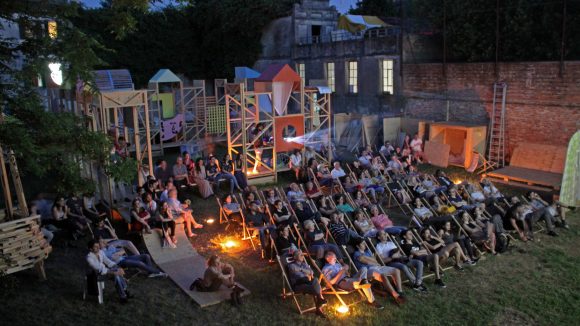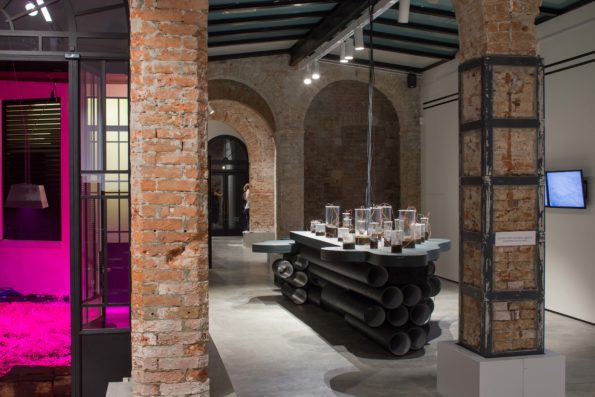Search
To search for an exact match, type the word or phrase you want in quotation marks.
A*DESK has been offering since 2002 contents about criticism and contemporary art. A*DESK has become consolidated thanks to all those who have believed in the project, all those who have followed us, debating, participating and collaborating. Many people have collaborated with A*DESK, and continue to do so. Their efforts, knowledge and belief in the project are what make it grow internationally. At A*DESK we have also generated work for over one hundred professionals in culture, from small collaborations with reviews and classes, to more prolonged and intense collaborations.
At A*DESK we believe in the need for free and universal access to culture and knowledge. We want to carry on being independent, remaining open to more ideas and opinions. If you believe in A*DESK, we need your backing to be able to continue. You can now participate in the project by supporting it. You can choose how much you want to contribute to the project.
You can decide how much you want to bring to the project.

The 16th Venice Architecture Biennale, curated by Yvonne Farrell and Shelley McNamara, directors of Grafton Architects, explores the idea of free open space and its qualities. According to director of the Biennale Paolo Baratta, the intention of this project is to promote the desire for architecture. As can be expected before such a large-scale event, the answers suggested by the countries taking part are discordant and asymmetrical, and some of them complex. Over and above the openness or vagueness of the theme, the ambiguity that the curatorial project could provoke, the biennale reveals the state of global architectural thinking, most of which is characterised by excesses of meaning introduced with forceps and the idealisation of the expert as a messiah.
The British Pavilion and others seek to express the current sociopolitical state of their respective countries. What’s the point of a biennial if it doesn’t reflect on social issues and their interactions from the discipline in question? And what’s the purpose of a discipline if it is not connected to the world? Aptly entitled Island, it presents an empty space defined by an outside staircase made of industrial scaffolding that directs spectators to an elevated piazza, apparently formwork intended hold a new slab. And all that is left, all that takes place, is the wait (while you’re served a cup of tea). According to the curators, the empty interior will be a stage for students, musicians and other artists who will use it during the Biennale. This slightly worn gesture of leaving the pavilion’s halls empty makes sense in the face of the isolationism of the administration of the United Kingdom. It would be a powerful gesture if it weren’t a patina of nostalgia before the death rattle announcing the end of the British Empire.
Along the same lines, the Scottish Pavilion is a simple structure that acts as a platform for unspecified activities. Entitled The Happenstance, as a manifesto that combines performativity and political resistance, it could perhaps be considered naïve or stereotyped, but precisely on account of the nature of an event designed for the global elite, its location – outside of the Arsenale and the Giardini – is effective. In the district of Dorsoduro, the pavilion consists of a playground in a backyard reached through an alley, with inflatable sculptures and blankets framing the entrance to the pavilion — a wooden structure with children’s games, an improvised football pitch, film screenings, informal concerts and rest areas. This is how the Scots suggest establishing relationships with the inhabitants of the island, usually disturbed by the excess of tourists and the eccentricities that emerge around the Biennale. Walking down the Via Fondamento del Soccorso we come across an event that reveals the situation. A small group of artists has built a simple floating bridge to cross the canal, interrupting the traffic of rowboats during the time it took to set up and cross, no more than ten minutes. This action prompted a Venetian resident to call out to artists and spectators to respect the land of Saint Marks’, its canals and its inhabitants, while waving a red flag with the golden lion that symbolises the island (I can assure you that I’m not making the story more colourful!).

Scottish Pavilion.
One of the inclusive gestures in The Happenstance is the decision to invite students to collaborate on the project. One of the collaborators, the Spaniard Lucía Uriarte, explains the main intention of the pavilion — to challenge the structure that shapes such spaces and their accesses, showing a commitment with young communities, thereby responding to the theme of the Biennale. Of course, we have to say that this vision, albeit charismatic, mirrors the utopian intentions that have made the messianic discourse characterising contemporary architects fruitless. With their insistence on community making, they seem to regard the city as a Monopoly board with quotes by Lefebvre and David Harvey on the cards.
Yet architecture as a method of exploration can be really interesting, as we see in the pavilions of Lithuania, Estonia and the United States, where rigorous research has revealed discourses that transcend the simple playful doing-good model of several pavilions or the cerebral nihilism devoid of emotional power of others. The Lithuanian Pavilion, titled The Swamp, made by Studio Urbonas in collaboration with several institutions from around the world, explores the ecosystem of the swamp as a platform for thinking about hybrid situations between architectural and artistic practices, theory and teaching. Choosing not to represent a territory but to use the Biennale instead as a starting point for more productive debates, The Swamp comprises workshops, lectures, field trips and a school. Another project is Hybrid Radio by Nicole L’Huillier. With this artefact, the Chilean artist based in Boston tries ‘to re-think radio communication as an open tool for transmitting and receiving in order to create streams for civic communication, engagement, and expression … to re-appropriate the space of the airwaves that has been drastically regulated, privatized and institutionalized.’ The Swamp suitably forgets about the prevalence of the image in architectural debate and pays attention instead to other senses and other spatial agents. One of the installations inside the swamp addresses our sense of smell, that is not often the object of a discipline apparently obsessed with sensuousness and its ability to create memory and inter-national and inter-specific without resorting to symbols.

The Swamp. Photo Norbert Tukaj.
Estonia proposes an oxymoron. Weak Monuments is certainly a convincing example, as opposed to the power of thought, its contradictions and political specificity. Seeking to explore the limits between public space and the representation of memory, Estonia makes a clear statement regarding the problematics of monuments. As the expression of a determined will, a monument is an imposition rather than a representation, the legitimation of a discourse turned into matter in public space. The idea of weakness, or perhaps subtlety, assumes a surprising flexibility and resonance. The first work in the pavilion is a piece of a public bench that literally allows a flowing movement through the city, like a staircase that grants access to different levels of visibility and interaction between body, memory and action (even though this may be a cheap metaphor and its implications obvious). Here, the importance of the forum and the cliché of the staircase as a collective subjectivity also acquire dimensions able to spark more fruitful thinking than the reasoning that could be induced by an identity carved in stone.
And speaking of stones, unfortunately the only echo produced by the Mexican Pavilion is that of a stone tossed into what remains of Lake Texcoco. Echoes of a Land goes unnoticed, partly because of its nostalgia for what appears to be the yearning for a sublime timelessness. While it is understandable that the curator’s approach should tend towards the common territory, the hesitancy to approach a relevant and necessary discussion for a discipline that is precisely the conjunction between the population and the government is highly revealing of the present state of architectural (and political) thought. Petrified and anachronistic. The pavilion is merely a fine catalogue of stone mock-ups that condense the basic gestures of the participant projects. It is quite likely, of course, that the budget partly justifies these decisions, but if we are ‘condemned to be modern’ (materially) as foretold by a previous pavilion, we may at least try to speak of something other than the same old romantic foundations. Moving from the representation of ideals (yes, even though they appear in complex territories they are idealisations) to the articulation of realities that transcend the formal is probably something that young practitioners should consider if we are pointing to a fertile and acutely critical discipline.
And what about the Spanish Pavilion? An explosion of this virtuosity in graphic representation that could well have been only a book. Too much information to be absorbed from experience. Such demands of time and attention would be worthwhile if they were articulated in the space of the pavilion and not just superimposed on the walls, where, more than imagining a discourse, the content resembles the background noise of a critical present. And here we could ask a slightly broader question: Is architecture able to transcend representation in its research? If space, as is proclaimed, is born and shapes desire, it would seem that excess isometry is merely corporate masturbation, for its endogamic eroticism leaves no room for other aesthetic promiscuousness, hence for other spaces beyond the world of experts and technicians.

Spanish Pavilion: Becoming. Photo: Ismael Arriola.
Dimensions of Citizenship is the title of the American Pavilion, curated by Ann Lui, Mimi Zeiger, Neil Atkins and Iker Gil. Citizen, Civitas, Region, Nation, Globe, Network and Cosmos are the themes through which the pavilion strives to explore issues of citizenship and its implications in constructed and discursive space at different levels. Works like the video-installation by Diller Scoffidio + Renfro, in collaboration with Laura Kurgan, Robert G. Pietrusko and the Centre for Spatial Research at Columbia University, open up a relevant space for discussing the asymmetries between social reality and representation. Analysing nocturnal satellite pictures that focus on the brightest points of the globe, they present a dissection of the activities carried out in these areas: with no light yet with a high population density, or brightly lit yet without inhabitants. These pictures reveal that through the use of these images certain political agents make decisions and propose laws based on hard facts that are deceptive. They reveal the binarism in the representation of the world: rural/urban, developed/non-developed, rich/poor. The problem of this device is that it doesn’t only represent but actually constructs the subjects it studies. Shiben Banerji, who took part as a lecturer in one of the several forums organised in the pavilion, observes that these binarisms are precisely technologies to globalise the world, a device for the creation of that other that is a point of extraction. Banerji notes that while we need to escape from this dichotomy, we should first recognise the violence implicit in the so-called right to citizenship, as, according to him, a right is only a right if it has the capacity of being violently imposed, by force. At this precise point, in this lack of recognition of the violence implicit in the regime of citizenship, lie the insufficiencies of the utopianism we mentioned earlier. To ‘cure ourselves of our addiction to growth’ it may be worthwhile to think not of a right to the city but of a duty of the city.
But there is still a place for playful sensuousness. The Northern European Pavilion Another Generosity suggests another form of interaction between human and non-human agents. A series of pneumatic structures respond to the sense of touch, inflating or deflating according to the condition previous to the interaction with the body of the visitor, an awakening of bodies through closeness. The reference to genitalia – complex despite its obviousness –suggests that at a certain level, all creations and reactions are amorous, desirous. And if this is the case, what qualities should a space and an object have or insinuate in order to provoke such embedded reasoning, and therefore knowledge? Perhaps the answer lies where it is less visible, in the light touches of everyday life that, as mentioned in one of the several conversations we held with Banerji, is the locus of our affections and tensions as we construct the world, precisely because it readjusts desire — a desire that is not messianic but banal.
*Cover image: Nordic Pavilion Another Generosity. Photo: Ugo Carmeni.

"A desk is a dangerous place from which to watch the world" (John Le Carré)